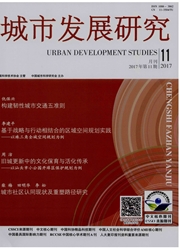

 中文摘要:
中文摘要:
我国为数众多的城市实施了多中心空间政策和新城新区建设,但是多中心结构的绩效尤其是能耗绩效亟待检验。首先分析了多中心城市在理想状态下的生产能源、建筑能源和交通能源节约,并利用2010年中国地级及以上城市数据,实证检验了多中心结构对于单位GDP能耗和人均能耗的影响。结果发现,城市的多中心程度与单位GDP能耗和人均能耗呈现显著负相关,即城市多中心程度的提高会降低城市的人均能耗和单位GDP能耗,具有更好的生态绩效,这在一定程度上为多中心城市空间发展政策提供了生态维度的依据。此外,城市规模扩大、密度提高以及城市交通基础设施完善都有利于提高能耗绩效,而人均收入水平、第二产业比重和私人交通工具出行比重的提高都会使城市能耗绩效变差。
 英文摘要:
英文摘要:
Most cities in China have planned to construct new towns or sub-centers,but the energy consumption performance of the polycentric urban structure remains unclear. This paper analyzes the energy saving of polycentric city in terms of production,building,transportation qualitatively,then uses the 2010 data of the prefecture-level and above cities in China,empirically to examine the impact of polycentric urban structure on energy consumption per capita and per unit GDP respectively. It is found that the polycentricity of cities is negatively associated with energy consumption per unit GDP and per capita,which indicates that a polycentric city has a better energy consumption performance than a mono-centric city. In addition,urban size,density and transportation infrastructure condition positively relate to the improvement of energy consumption performance,and the rises of income per capita,share of secondary sector in GDP and share of private cars in all mode choices result in much higher energy consumption level.
 同期刊论文项目
同期刊论文项目
 同项目期刊论文
同项目期刊论文
 期刊信息
期刊信息
